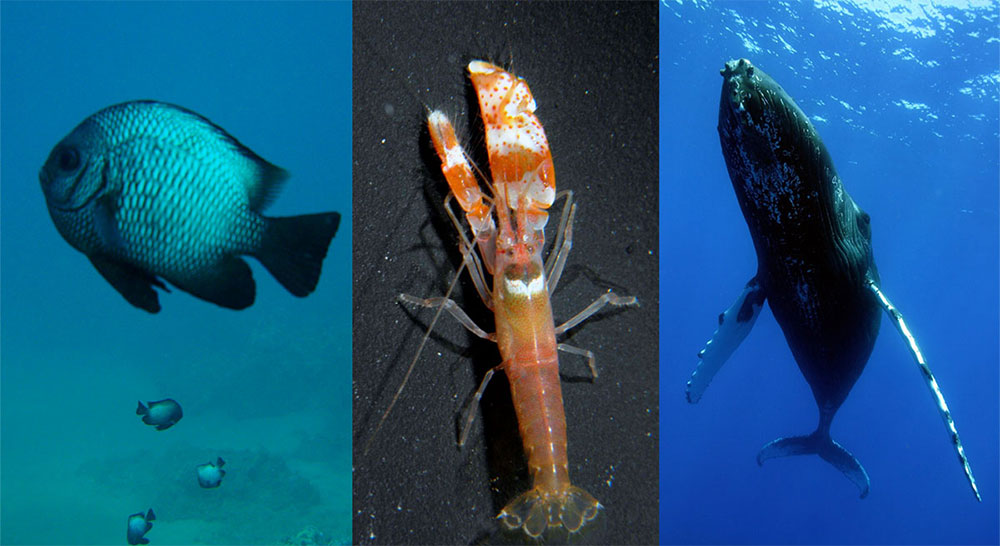Noise
Hawaiian Islands Humpback Whale

Why is it a concern?
The Hawaiian Islands Humpback Whale sanctuary provides habitat for many vocally active and acoustically sensitive marine species including endangered and protected animals such as whales and dolphins as well as commercially and ecologically important fishes and marine invertebrates such as snapping shrimp, parrotfish, butterflyfish, and triggerfish. There are many human uses that occur in sanctuary waters such as shipping of goods, military activities, research, and ocean recreation, which are all potential contributors of noise to the underwater environment or soundscape. Meeting protection and management objectives thus necessitates: the characterization of noise influences to sanctuary species and habitats, understanding the implications, and designing mitigation techniques to address negative consequences. Additionally, soundscapes can provide indicators of ecosystem diversity and health that can be assessed over time or in relation to human activity levels.
Research is needed in this area to further understand how noise might impact the behavior of marine organisms. Studies have documented behavioral responses, lost listening opportunities, and physical injuries to wildlife due to exposure to anthropogenic (human-induced) noise. Effects from high decibel noise, especially at close range, can cause acute physiological effects in living marine resources, such as tissue damage in lungs and ears and ruptured or hemorrhaged body parts. Other effects include the masking of important signals (such as those used for echolocation, inter-species communication, and predator-prey cues), behavioral alterations (such as changes in migration patterns or abandonment of important habitats), and adverse effects to animal energy and physiology. Additionally, fish and invertebrates may experience damage to eggs, reduced reproduction rates, and physiological or morphological damage. Noise may also cause marine mammals and other organisms to acquire temporary or permanent hearing loss. The disorientation and hearing loss may account for cases in which ships collide with marine mammals that are apparently unaware of the approaching vessel. Most strikes occur in coastal waters on the continental shelf where large marine mammals concentrate to feed.
Overview of Research
| Project Name | PI and contacts | Links |
|---|---|---|
Passive acoustic monitoring |
Marc Lammers |
|
Passive acoustic monitoring |
NOAA Pacific Islands Fisheries Science |
http://www.pifsc.noaa.gov/cetacean/passive_acoustic_monitoring.php |
Marine Mammal Research Program |
Hawaii Institute of Marine Biology |
Science Needs and Questions
- What are the relative inputs of sound from various sources to the sanctuary’s total “ocean noise budgets,” and how do they vary at temporal and spatial scales?
- What are the temporal/spatial distributions of vocalizing marine animals in the sanctuary?
- Are changes in the behaviors of vocally-active marine animals relative to anthropogenic sound sources biologically significant, and how can this information inform underwater noise policy for the sanctuary?
Education and Outreach Material
Discovery of Sound in the Sea website offers many resources related to the issue of noise in the ocean.
Podcast on Noise and Soundscapes in National Marine Sanctuaries with Dr. Leila Hatch.
References
Clark, C.W., W.T. Ellison, B.L. Southall, L.T. Hatch, S.M. Van Parijs, A. Frankel & D. Ponirakis. 2009. Acoustic Masking in Marine Ecosystems: Intuitions, Analysis, and Implications. Marine Ecology Progress Series 395:201-222
Hatch, L.T., Clark, C.W., Merrick, R., Van Parijs, S., Ponirakis, D., Schwehr, K., Thompson, M. & Wiley, D. (2008). Characterizing the relative contributions of large vessels to total ocean noise fields: a case study using the Gerry E. Studds Stellwagen Bank National Marine Sanctuary. Environmental Management.
Hatch, L.T. & K.M. Fristrup. 2009. No barrier at the boundaries: implementing regional frameworks for noise management in protected natural areas. Marine Ecology Progress Series. 395:223-244
Hatch, L. T., C. W. Clark, R. Merrick, S. M. Van Parijs, D. Ponirakis, K. Schwehr, M. Thompson, and D. Wiley. 2009. Erratum to: characterizing the relative contributions of large vessels to total ocean noise fields: a case study using the Gerry E. Studds Stellwagen Bank National Marine Sanctuary. Environmental Management 44:998-999.
National Research Council. 2003. Ocean Noise and Marine Mammals. The National Academies Press. Washington, DC.
Richardson, W.J., C.R. Greene, C.I. Malme, and D.H. Thomson. 1995. Marine Mammals and Noise. Academic Press. New York, NY.
Scheifele, P.M. and M. Darre (2005). Noise levels and sources in the Stellwagen Bank National Marine Sanctuary and the St. Lawrence River Estuary. Marine Conservation Series MSD-05-1. U.S. Department of Commerce, National Oceanic and Atmospheric Administration, Marine Sanctuaries Division, Silver Spring, MD. 26pp.

